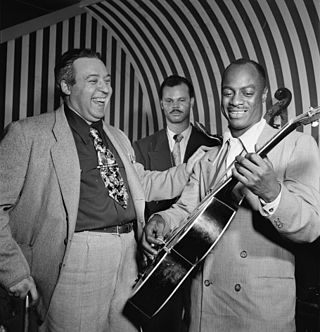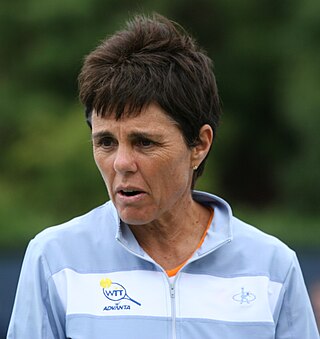Related Research Articles

Billie Holiday was an American jazz and swing music singer. Nicknamed "Lady Day" by her friend and music partner, Lester Young, Holiday made a significant contribution to jazz music and pop singing. Her vocal style, strongly influenced by jazz instrumentalists, inspired a new way of manipulating phrasing and tempo. She was known for her vocal delivery and improvisational skills.
Jeremy Steig was an American jazz flutist.
Donald Milton Clarke is an American writer on music.

The Citigroup Center is an office skyscraper in the Midtown Manhattan neighborhood of New York City. Built in 1977 for Citibank, it is 915 feet (279 m) tall and has 59 floors with a combined 1.3 million square feet (120,000 m2) of office space. The building was designed by architect Hugh Stubbins, associate architect Emery Roth & Sons, and structural engineer William LeMessurier.

Hugues Panassié was a French critic, record producer, and impresario of traditional jazz.

Leandro "Gato" Barbieri was an Argentine jazz tenor saxophonist who rose to fame during the free jazz movement in the 1960s and is known for his Latin jazz recordings of the 1970s. His nickname, Gato, is Spanish for "cat".
Leon Brown "Chu" Berry was an American jazz tenor saxophonist during the 1930s. He is perhaps best known for his time as a member of singer Cab Calloway's big band.

Marion Brown was an American jazz alto saxophonist, composer, writer, visual artist, and ethnomusicologist. He was a member of the avant-garde jazz scene in New York City during the 1960s, playing alongside musicians such as John Coltrane, Archie Shepp, and John Tchicai. He performed on Coltrane's landmark 1965 album Ascension. AllMusic reviewer Scott Yanow described him as "one of the brightest and most lyrical voices of the 1960s avant-garde."

Ilana Sheryl Kloss is a former professional tennis player, tennis coach, and commissioner of World TeamTennis from 2001–21. She was the World's No. 1 ranked doubles player in 1976, and World No. 19 in singles in 1979. She won the Wimbledon juniors singles title in 1972, the US Open juniors singles title in 1974, and the US Open Doubles and French Open Mixed Doubles titles in 1976. She won three gold medals at the 1973 Maccabiah Games in Israel.
The Half Note was a jazz club in New York City, New York that flourished in two Manhattan locations – from 1957 to 1972 in SoHo at 289 Hudson Street at Spring Street and from 1972 to 1974 in Midtown at 149 West 54th Street, one block west of the Museum of Modern Art.
"I've Got My Love to Keep Me Warm" is a popular song copyrighted in 1937 by its composer, Irving Berlin, and first recorded by (i) Ray Noble, Howard Barrie, vocalist; (ii) Red Norvo, Mildred Bailey, vocalist; (iii) and Billie Holiday with her orchestra. The song – sung by Dick Powell and Alice Faye – debuted on film February 12, 1937, in the musical, On the Avenue.
William T. Williams is an American painter and educator. He is known for his process-based approach to painting that engages motifs drawn from personal memory and cultural narrative to create non-referential, abstract compositions. He was a Professor of Art at Brooklyn College, City University of New York from 1971 to 2008.
Lawrence Lucie was an American jazz guitarist.

Dan Morgenstern is a jazz writer, editor, archivist, and producer. He is the son of the German-language Jewish author Soma Morgenstern.
Bobby Jones was an American jazz saxophonist.
Brian Arthur Lovell Rust was an English jazz discographer.

Metronome was a music magazine published from January 1885 to December 1961.
A & R Recording Inc. was a major American independent studio recording company founded in 1958 by Jack Arnold and Phil Ramone.
The Nest Club was a cabaret in Harlem, more specifically an afterhours club, at 169 West 133rd Street – a street known then both as "Swing Street" and "Jungle Alley" – two doors east of Seventh Avenue, downstairs. The club, operating under the auspices of The Nest Club, Inc., was founded in 1923, co-owned, and operated by John C. Carey (né John Clifford Carey; 1889–1956) and Mal Frazier (né Melville Hunter Frazier; 1888–1967). The club flourished through 1933. The U.S. Prohibition — a nationwide ban on the sale of alcoholic beverages — ran from 1920 to 1933. The club faced a formidable challenge to its viability following the Great Crash of October 1929, followed by the Great Depression that bottomed around March 1933.
Skippy Adelman was an American photographer, best known for his book Jazzways, featuring monochrome photography of jazz musicians, and for his contributions to the bygone New York City daily paper, PM, where he worked as a staff photojournalist.
References
Notes
- ↑ New York Times, December 11, 1972, p. 52.
- ↑ Record Research, August 1972, pp. 1, 5.
- ↑ Fischer, 2003.
- ↑ Fischer, August 13, 2021.
- ↑ Morgenstern, Gitler & Bradley, 1973.
- ↑ Giddins, Keepnews & Morgenstern, 1974.
- ↑ New York Times, April 17, 1973, p. 32.
- ↑ Kuehl & Schocket, 1973.
- ↑ Gelatt, Hooper & Quinn, July 16, 1974.
- ↑ New York Times, February 27, 1973, p. 28.
- ↑ Morgenstern, 1973.
- ↑ Music America Magazine, April 1977, p. 38.
- ↑ New York, June 19, 1972, p. 63.
- ↑ Washington International Arts Letter, 1974, p. 76.
Citations
Secondary sources
- "New York Jazz Museum" . Music America Magazine. Vol. 1, no. 6. April 1977. p. 38. ISSN 0145-5419. OCLC 2750697 – via Internet Archive.
- "All That Jazz". New York . 5 (25): 63. June 19, 1972 – via Google Books.
- "Help for Museum in Distress" . The New York Times . Vol. 122, no. 41960. February 27, 1973. p. 52.
- McDonagh, Don (February 27, 1973). "Jazz Lures Tap Talent to Museum" . The New York Times . Vol. 122, no. 42038. p. 28.
- Wilson, John Steuart (April 17, 1973). "Aura of Billie Holiday is Captured at the Jazz Museum" . The New York Times . Vol. 122, no. 42087. p. 32.
- Kunstadt, Leonard Richard (August 1972). "New York Jazz Museum Opens, Friday, June 16, 1972". Record Research . No. 117. pp. 1, 5. Retrieved September 22, 2022– via Internet Archive.
- Millsaps, Daniel Webster, ed. (1974). Private Foundations & Business Corporations Active in Arts / Humanities / Education . The Arts Patronage Series. Vol. 2. Washington, D.C.: Washington International Arts Letter. p. 76. ISBN 978-0-9120-7205-0. LCCN 77140925. OCLC 1602135 – via Internet Archive.
Primary sources
- Fischer, Howard E. (2003) [2004]. Jazz Exposé: The New York Jazz Museum and the Power Struggle That Destroyed It. Nashville: Sundog. ISBN 978-1-9322-0387-5. OCLC 57394563 – via Google Books.[ self-published source? ]
- Fischer, Howard E. (August 13, 2021). "The New York Jazz Museum: 1972–1977". All About Jazz . Retrieved September 22, 2022.
- Gelatt, Tim; Hooper, Ray; Quinn, Bill (July 16, 1974). About John Coletrane . New York Jazz Museum. OCLC 3842071 – via Internet Archive.
- Giddins, Gary; Keepnews, Peter; Morgenstern, Dan (1974). The Sax Section – Biographical Sketches. New York Jazz Museum. OCLC 3842152.
- Kuehl, Linda; Schocket, Ellie (1973). Billie Holiday Remembered. New York Jazz Museum. LCCN 77373175. OCLC 1358163.
- Morgenstern, Dan (1973). The Jazz Story – An Outline History of Jazz . New York Jazz Museum. LCCN 77365219. OCLC 6580574 – via Internet Archive..
- Morgenstern, Dan; Gitler, Ira; Bradley, Jack, eds. (1973). Bird & Diz – A Bibliography. New York Jazz Museum. LCCN 77374454. OCLC 3630048.